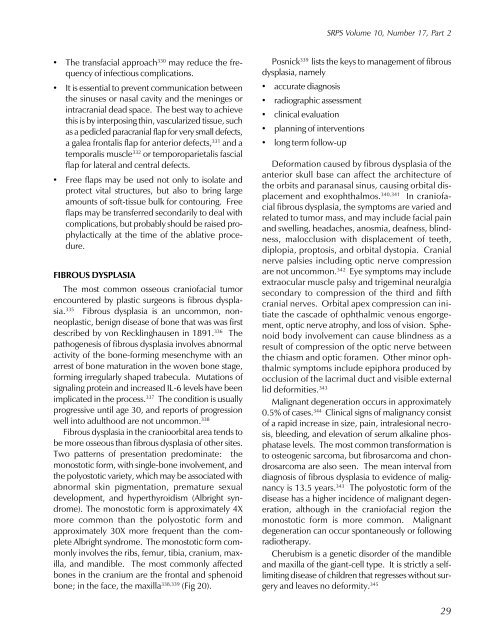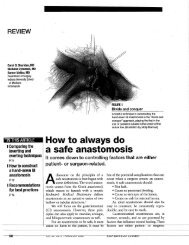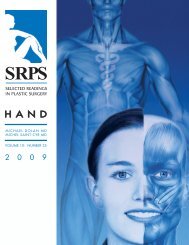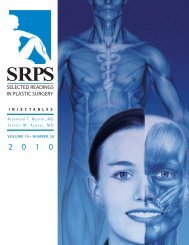Craniofacial Anomalies, Part 2 - Plastic Surgery Internal
Craniofacial Anomalies, Part 2 - Plastic Surgery Internal
Craniofacial Anomalies, Part 2 - Plastic Surgery Internal
You also want an ePaper? Increase the reach of your titles
YUMPU automatically turns print PDFs into web optimized ePapers that Google loves.
• The transfacial approach330 may reduce the frequency<br />
of infectious complications.<br />
• It is essential to prevent communication between<br />
the sinuses or nasal cavity and the meninges or<br />
intracranial dead space. The best way to achieve<br />
this is by interposing thin, vascularized tissue, such<br />
as a pedicled paracranial flap for very small defects,<br />
a galea frontalis flap for anterior defects, 331 and a<br />
temporalis muscle332 or temporoparietalis fascial<br />
flap for lateral and central defects.<br />
• Free flaps may be used not only to isolate and<br />
protect vital structures, but also to bring large<br />
amounts of soft-tissue bulk for contouring. Free<br />
flaps may be transferred secondarily to deal with<br />
complications, but probably should be raised prophylactically<br />
at the time of the ablative procedure.<br />
FIBROUS DYSPLASIA<br />
The most common osseous craniofacial tumor<br />
encountered by plastic surgeons is fibrous dysplasia.<br />
335 Fibrous dysplasia is an uncommon, nonneoplastic,<br />
benign disease of bone that was was first<br />
described by von Recklinghausen in 1891. 336 The<br />
pathogenesis of fibrous dysplasia involves abnormal<br />
activity of the bone-forming mesenchyme with an<br />
arrest of bone maturation in the woven bone stage,<br />
forming irregularly shaped trabecula. Mutations of<br />
signaling protein and increased IL-6 levels have been<br />
implicated in the process. 337 The condition is usually<br />
progressive until age 30, and reports of progression<br />
well into adulthood are not uncommon. 338<br />
Fibrous dysplasia in the cranioorbital area tends to<br />
be more osseous than fibrous dysplasia of other sites.<br />
Two patterns of presentation predominate: the<br />
monostotic form, with single-bone involvement, and<br />
the polyostotic variety, which may be associated with<br />
abnormal skin pigmentation, premature sexual<br />
development, and hyperthyroidism (Albright syndrome).<br />
The monostotic form is approximately 4X<br />
more common than the polyostotic form and<br />
approximately 30X more frequent than the complete<br />
Albright syndrome. The monostotic form commonly<br />
involves the ribs, femur, tibia, cranium, maxilla,<br />
and mandible. The most commonly affected<br />
bones in the cranium are the frontal and sphenoid<br />
bone; in the face, the maxilla338,339 (Fig 20).<br />
SRPS Volume 10, Number 17, <strong>Part</strong> 2<br />
Posnick339 lists the keys to management of fibrous<br />
dysplasia, namely<br />
• accurate diagnosis<br />
• radiographic assessment<br />
• clinical evaluation<br />
• planning of interventions<br />
• long term follow-up<br />
Deformation caused by fibrous dysplasia of the<br />
anterior skull base can affect the architecture of<br />
the orbits and paranasal sinus, causing orbital displacement<br />
and exophthalmos. 340,341 In craniofacial<br />
fibrous dysplasia, the symptoms are varied and<br />
related to tumor mass, and may include facial pain<br />
and swelling, headaches, anosmia, deafness, blindness,<br />
malocclusion with displacement of teeth,<br />
diplopia, proptosis, and orbital dystopia. Cranial<br />
nerve palsies including optic nerve compression<br />
are not uncommon. 342 Eye symptoms may include<br />
extraocular muscle palsy and trigeminal neuralgia<br />
secondary to compression of the third and fifth<br />
cranial nerves. Orbital apex compression can initiate<br />
the cascade of ophthalmic venous engorgement,<br />
optic nerve atrophy, and loss of vision. Sphenoid<br />
body involvement can cause blindness as a<br />
result of compression of the optic nerve between<br />
the chiasm and optic foramen. Other minor ophthalmic<br />
symptoms include epiphora produced by<br />
occlusion of the lacrimal duct and visible external<br />
lid deformities. 343<br />
Malignant degeneration occurs in approximately<br />
0.5% of cases. 344 Clinical signs of malignancy consist<br />
of a rapid increase in size, pain, intralesional necrosis,<br />
bleeding, and elevation of serum alkaline phosphatase<br />
levels. The most common transformation is<br />
to osteogenic sarcoma, but fibrosarcoma and chondrosarcoma<br />
are also seen. The mean interval from<br />
diagnosis of fibrous dysplasia to evidence of malignancy<br />
is 13.5 years. 343 The polyostotic form of the<br />
disease has a higher incidence of malignant degeneration,<br />
although in the craniofacial region the<br />
monostotic form is more common. Malignant<br />
degeneration can occur spontaneously or following<br />
radiotherapy.<br />
Cherubism is a genetic disorder of the mandible<br />
and maxilla of the giant-cell type. It is strictly a selflimiting<br />
disease of children that regresses without surgery<br />
and leaves no deformity. 345<br />
29






